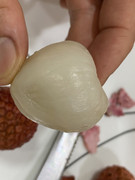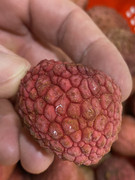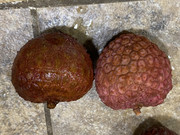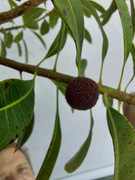I just received my order and these Noumichi were just Ok. Whatever they did to these fruit really killed the flavor. Not sure if it was hot water treated or irradiated or just the transport time but these taste like generic Lychees. From the pebbly skin, color, shape and taste, they are the real No Mai Tsze but donít even come close to the fresh ones in Hong Kong and China.
In Asia, they sell the lychees still attached to the panicles and often with the branch and some leaves. These fruit have no distinguishing taste profile other than sweet with a tiny bit of subacid. There is no Lychee flavor or so little that itís hardly noticeable.
The one thing that anyone that purchased these fruit may notice is that it is a dry type Lychee and when you peel the skin off, very little juice leaks out. When you peel something like a Brewster or Sweetheart, juice gushes out everywhere.
Hereís a picture of a peeled Noumichi fruit, notice how dry the flesh is

Pebbly looking peel characteristic of this variety

Noumichi next to some frozen Kaimana

Brix for the Noumichi averaged around 15% with a high of 15.6%
I would not judge No Mai Tsze from these fruit.
Simon


















